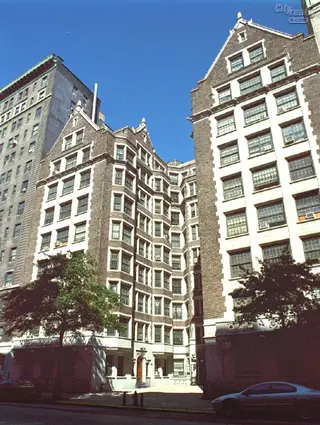 Carter Horsley
Carter HorsleyDec 23, 2011
Carter's Review
Cathedral Parkway is an impressive cross-street that occupies part of West 110th Street near the Cathedral Church of St. John The Divine nearby to the north.
This mid-block, 9-story building of 1909 is its finest structure even though it has long since been overshadowed by taller pre-war apartment buildings.
What makes it so fine, of course, are its wonderful "grotesques," or non-waterspouting gargoyles and its much larger than usual center light court and entrance.
In his January 16, 2009 article in The New York Times entitled "Meet Me Under the Gobbling Gargoyles," Christopher Gray asked "Does a gaggle of grimacing gargoyles make you think of home?"
With no reference to the Quasimodos of the world, Mr. Gray noted that Architects' and Builders' Magazine called the building, which is known as The Britannia, as "perhaps the most homelike apartment house in New York."
"Although five- and six-story apartment buildings were common around the turn of the last century," the article continued, "after 1905 taller structures became the rule where land costs were high. This was a new form, and for a few years developers were open to experimentation. In 1908, Gracehill Realty, of which J. Charles Weschler was the president, bought a plot between Broadway and Amsterdam Avenue" on 110th Street and "hired Waid & Willauer, and instead of ordering a 12-story building like those going up elsewhere on the street, he had them experiment with a more distinctive, lower building - only nine stories. Revenue was sacrificed for architectural effect."
According to Mr. Gray, the Real Estate Record and Guide said that this building at 527 West 110th Street was reminiscent of "'the old English house,' with flanking wings, a central courtyard and multipaned windows," adding that "Courts opening onto streets were often used to provide light, but almost always at the minimum widths prescribed by the building code, or about 20 feet. Mr. Willauer said they were narrow enough to hear the neighbors gossip." His courtyard here is 35 feet wide with sidewalk landscaping.
There are gargoyles flanking the building's courtyard entrance but the most prominent are along the street above the first-story windows and beneath the bay windows above. "A series of crouched, grimacing figures in limestone runs across each wing: a cook stirring a pot, taking a taste with his finger; a man with a spoon eagerly eating from a bowl; another carrying a platter with a roast chicken; and a man with a long flowing beard writing in a ledger with a quill pen," according to Mr. Gray's description. Another writer has described the structure as the "chicken-soup building."
The Britania had apartments with five to nine rooms, Mr. Gray noted,
"with rents of $90 to $250 per month," adding that Mr. Weschler built "a few other buildings, but none so ambitious as the Britania, and soon apartment houses settled into the conventional patterns....What sparked Mr. Weschler to build this Anglophile structure is difficult to fathom. He was born in Alexandria, Egypt, the son of the Austrian consul, but he studied at City College and New York University's law school....He was among the building's first tenants and stayed on after he sold it in 1910."
The building was converted to a condominium in 1986.
It has 10-foot-high ceilings and private storage and its two wings have peaked roofs.

- Condo built in 1909
- Converted in 1986
- Located in Morningside Heights
- 56 total apartments 56 total apartments
- 10 recent sales ($540.7K to $1.4M)
- Doorman
- Small Pets Allowed only

 6sqft delivers the latest on real estate, architecture, and design, straight from New York City.
6sqft delivers the latest on real estate, architecture, and design, straight from New York City.
